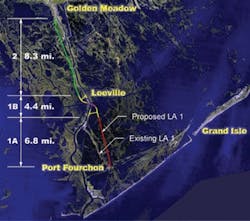Coalition arranges for new, segmented funding from Louisiana DOT
This past October, the LA 1 Coalition lost their bid for a $100-million federal grant, but continues to seek government aid – this time, at the state level – in helping to build the remainder of its Phase 2 of the Louisiana Highway 1 Improvement Project in Lafourche Parish.
The coalition is a non-profit corporation formed by residents and businesses in the region around Port Fourchon to improve the highway that connects the port and its surrounding area with the rest of the United States. A key member of the coalition is the Greater Lafourche Port Commission.
The ultimate objective of the LA 1 project is a new raised highway linking Port Fourchon, along with Grand Isle in neighboring Jefferson Parish, with the rest of the country. When completed, it will serve as a federally designated High Priority Corridor, almost totally invulnerable to the tidal surges wrought by the Gulf of Mexico hurricanes and gales that have plagued its original road bed for more than half a century.
Today, however, while it leads to the nation’s only offshore port with proximity to the part of the central Gulf where deepwater and ultra-deepwater drilling takes place, certain stretches of the highway are often flooded by torrential rains and high tides associated with storms.
What’s more, it is the only means of evacuation for some 35,000 residents of southern Lafourche Parish and Grand Isle, with evacuated offshore workers increasing that number by nearly half. Once rising flood waters cover the highway, vehicular evacuation becomes impossible.
And lastly, interstate truck traffic from U.S. 90 to Port Fourchon, particularly along its current road bed through wetland areas below the city of Larose, has increased in some years by as much as 24%. Fatal accidents are on the upswing, and trucks bringing mostly drilling consumables – tubular goods and well equipment, drilling fluids, cement and chemicals, among other supplies – keep the portions of the road not yet upgraded in constant disrepair, with the associated slowdowns.
Romancing Phase 2
Phase 2 of the project comprises an 8.3-mi, double lane elevated roadway from the community of Golden Meadow south to Leeville, where it will connect with the already installed Tomey Doucet Toll Bridge over Bayou Lafourche; and then with the nearly completed Phase 1 project, a two-lane section of elevated highway stretching from Leeville to Port Fourchon, an earlier phase scheduled for completion this summer. There, it meets with LA 3090 and existing LA 1, which runs for another eight miles to Grand Isle, itself a future upgrade candidate.
Phase 2 of the LA 1 Improvement Project will be built in segments.
Last August, the coalition applied for an infrastructure grant under a federal government process known as the Transportation Investment Generating Economic Recovery (TIGER) program. The application was for $100 million of the $600 million pigeon-holed for the TIGER program for fiscal 2010. The grant would have funded a significant portion of Phase 2.
However, in October, when the U.S. Transportation Dept. announced the list of more than 70 projects around the country that would be awarded the TIGER grants (with the highest single grant being $47.7 million), the coalition application was passed over – apparently for being too expensive.
Back to Square 1
According to Henri Boulet, LA 1 Coalition executive director, real and forecasted budget constraints at both the federal and state levels at this time will make it nearly impossible to amass the estimated $285 million necessary to bid out Phase 2.
But nobody’s giving up.
The group asked Louisiana’s Dept. of Transportation to consider segmenting its construction budgets for future Phase 2 funding into three parts so that each section, with matching funds from federal and private sources, could be built as the money became available.
“The DOTD recently agreed to do so,” said Boulet. “The $285 million likely will be divided into segments of $40 million, $45 million and $200 million.” He added that the coalition is now monitoring development of highway and energy bills in the new U.S. Congress, and looking for other federal and state government funding wherever it may be discovered. The remainder of Phase 2 funding would be covered by private financing.
Offshore Articles Archives
View Oil and Gas Articles on PennEnergy.com




